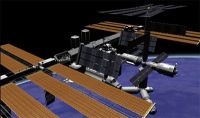Difference between revisions of "International Space Station"
(small add and link) |
Soumya-8974 (talk | contribs) |
||
| (9 intermediate revisions by 5 users not shown) | |||
| Line 1: | Line 1: | ||
| − | The '''International Space Station''' is | + | [[Image:ISS.jpg|200px|thumb|right|International Space Station]] |
| + | The '''International Space Station''' (ISS) is a space station, a very large satellite that people can live in for several months at a time. It was put together in Low Earth orbit up until 2011, but other bits have been added since then. The last part, a European module was added in 2018. The station is a joint project among several countries: the United States, Russia, Europe, Japan, and Canada. Other nations such as Brazil, Italy, and China also work with the ISS through cooperation with other countries. Orbiter contains the ISS in its completed state. The ISS is a good docking target for Shuttle and other spacecraft missions. It's [[Docking port|docking port]] shapes are all fictional and fitting for [[Delta-glider]] and [[Shuttle-A]]. | ||
| − | |||
| − | + | ==''Orbiter'' data== | |
| − | [ | + | |
| + | In ''Orbiter'', the ISS can be tracked with its transponder (XPDR) signal, which by default is set | ||
| + | to frequency 131.30. | ||
| + | |||
| + | The ISS contains 5 docking ports. In ''Orbiter'', each is equipped with an IDS transmitter. The default IDS frequencies are: | ||
| + | * Port 1 137.40 | ||
| + | * Port 2 137.30 | ||
| + | * Port 3 137.20 | ||
| + | * Port 4 137.10 | ||
| + | * Port 5 137.00 | ||
| + | |||
| + | ==See also== | ||
| + | * [[w:International space station|International Space Station]] on Wikipedia. | ||
| + | * [[ISS:List of Acronyms and Abbreviations]] | ||
{{Stub}} | {{Stub}} | ||
| + | |||
| + | [[Category:space station]] | ||
| + | [[Category:ESA]] | ||
| + | [[Category:Russia]] | ||
| + | [[Category:NASA]] | ||
Revision as of 07:58, 25 February 2019
The International Space Station (ISS) is a space station, a very large satellite that people can live in for several months at a time. It was put together in Low Earth orbit up until 2011, but other bits have been added since then. The last part, a European module was added in 2018. The station is a joint project among several countries: the United States, Russia, Europe, Japan, and Canada. Other nations such as Brazil, Italy, and China also work with the ISS through cooperation with other countries. Orbiter contains the ISS in its completed state. The ISS is a good docking target for Shuttle and other spacecraft missions. It's docking port shapes are all fictional and fitting for Delta-glider and Shuttle-A.
Orbiter data
In Orbiter, the ISS can be tracked with its transponder (XPDR) signal, which by default is set to frequency 131.30.
The ISS contains 5 docking ports. In Orbiter, each is equipped with an IDS transmitter. The default IDS frequencies are:
- Port 1 137.40
- Port 2 137.30
- Port 3 137.20
- Port 4 137.10
- Port 5 137.00
